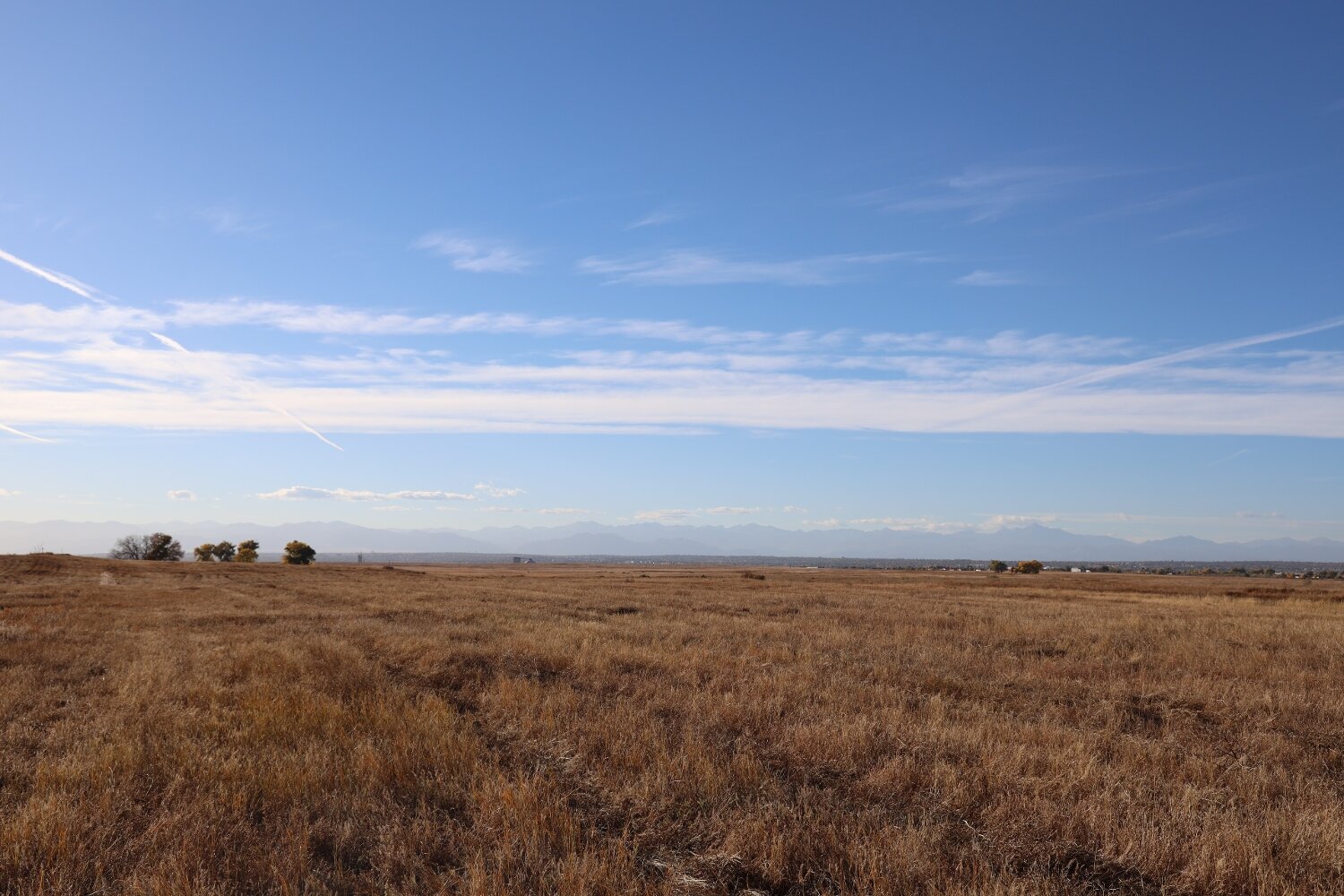Restoring Colorado’s not-so-plain grasslands, one ferret at a time

COMMERCE CITY, COLO. — The late afternoon sun cast a golden light across the grassy plains at Rocky Mountain Arsenal National Wildlife Refuge. About a dozen journalists and wildlife experts gathered around a prairie dog burrow, staring intently at the small animal carrier sitting in the dirt next to the mound.
A loud chatter erupted from the carrier, and the crowd got its first glimpse of the animal inside, one that was considered extinct just 40 years earlier: the black-footed ferret.
On October 18, the refuge released 19 ferrets, bringing the landscape’s estimated ferret population to about 30.
According to the U.S. Fish and Wildlife Service, black-footed ferrets are North America’s most endangered mammal. Tracking this species in the wild is difficult, but estimates put the wild population at less than 500.
Nick Kaczor is the deputy refuge supervisor in the U.S. Fish and Wildlife Service’s Mountain Prairie Region. He previously worked as assistant manager at Rocky Mountain Arsenal National Wildlife Refuge, where he helped organize the reintroduction of black-footed ferrets to the refuge, along with a team of city, state and federal employees.
That effort began in 2013. In 2015, Kaczor witnessed the initial release of about 30 black-footed ferrets into the refuge.
“As a wildlife biologist, it’s one of the best feelings you can have to reintroduce a native species,” Kaczor said. “Watching others experience that same thing, it's remarkable and always something that will stick in my career.”
The black-footed ferret population thrived at the refuge, reaching about 90 individuals in 2018. Unfortunately, an outbreak of sylvatic plague — an ever-present disease in black-tailed prairie dog colonies — resulted in a major decline of the refuge’s prairie dog population.
Black-footed ferrets are entirely dependent on prairie dogs for food and shelter. They declined in number as a result.
Since then, Kaczor and the team have worked to manage sylvatic plague among the refuge’s prairie dog colonies and rebuild the population to a level that can support black-footed ferrets. One female ferret needs about 200 acres of prairie dog colony to support herself and her offspring, called kits.
A black-footed ferret is about half the size of a prairie dog, but that doesn’t stop it from taking a very aggressive hunting approach. The nocturnal ferrets enter a prairie dog burrow at night, attack and eat the prairie dogs living there and take over the burrow as their own home.
“They are very vicious,” Kaczor laughed. "We joke that they're cute, but they'll bite your face off.”
The cute-but-fierce ferrets face their own predators in swift foxes, red-tailed hawks, short-eared owls and American badgers. But the main challenges facing black-footed ferret populations are habitat loss and disease.
These factors brought the species to near-extinction 40 years ago. In the early 1970s, the last known wild ferret population was lost, and in 1980, the last black-footed ferret in captivity died.
In 1981, Wyoming ranchers discovered a small population of black-footed ferrets on their land, igniting efforts to breed the remaining ferrets in captivity and slowly reintroduce the animals to the wild.
“The black-footed ferret is probably the poster child for endangered species conservation,” said Siva Sundaresan, deputy director of the USWFS. “An animal that once was in the tens of thousands all across this country went down to less than a few dozen individuals that we then had to bring back and rear and now slowly repopulate across the West.”
Sundaresan works in Washington, D.C., but visited the Rocky Mountain Arsenal National Wildlife Refuge to participate in the ferret release and learn about the refuge’s grassland conservation efforts.
It’s not just grassland animals like the black-footed ferret that are endangered — the grassland ecosystem itself is in a precarious position.

Rocky Mountain Arsenal National Wildlife Refuge provides an ideal landscape for federal efforts to restore native grassland ecosystems.
“Most of our grasslands tend to be in the middle of our country that have, over the last sort of several centuries, been turned into farmlands or developments,” Sundaresan explained. “What we're trying to do here is to restore grasslands back to what they would have been several hundred years ago.”
If you stand where the gently sloping hills meet the horizon, the grasslands at Rocky Mountain Arsenal National Wildlife Refuge seem to stretch all the way to the mountains. At 15,000 acres, the site doesn’t extend quite that far, but it’s enough to make it an attractive candidate for federal funding and initiatives aimed at restoring native grassland ecosystems.
Both the Bipartisan Infrastructure Law and the Inflation Reduction Act provided funding to the refuge. Megan Klosterman, the deputy refuge manager at Rocky Mountain Arsenal National Wildlife Refuge, said that funding will help prevent fires, remove invasive species, combat climate change and improve buffalo habitats.
“At first glance, you don't see a lot of life out on the plains, right? It almost looks like a grass desert,” Klosterman said. “But when you start looking closer, you see all kinds of different wildlife out here. If you look even closer, at the vegetation, it's a whole biodiverse community of vegetation out here that you won't see anywhere else.”
At any size, healthy native grassland ecosystems support native pollinators, which benefit farming and food production, Sundaresan said. Larger areas like the refuge create opportunities to introduce wildlife like buffalo and black-footed ferrets.
Many of these large grassland areas are found in scarcely populated, rural areas. Rocky Mountain Arsenal National Wildlife Refuge’s proximity to Denver is an example of how these spaces can work in urban settings, too, Sundaresan said.
“To me, it's just personally, deeply meaningful that this can all happen in the backdrop of Denver,” he said. “We can do this in the midst of urban areas with big wildlife. And it's as good for the wildlife as it is for us.”
Carly Rose is the journalism intern at Rocky Mountain PBS and can be reached at carlyrose@rmpbs.org.